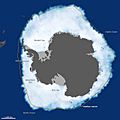Ice shelf facts for kids
An ice shelf is a very large, thick platform of ice. It forms where a glacier flows from land and extends out over the ocean. Ice shelves are usually at least 100 metres (330 ft) (about 330 feet) thick.
Some ice shelves float on the water, while others are still attached to the seabed. The parts that float are usually much thinner than the parts still connected to land.
The biggest ice shelves on Earth are found in Antarctica. They are huge areas of ice that float on the Southern Ocean.
- The Ross Ice Shelf is the largest, covering about 509,000 square kilometres (197,000 sq mi) (197,000 sq mi) as of 2013. That's roughly the size of Spain!
- The Filchner-Ronne Ice Shelf is the second largest, covering about 430,000 square kilometres (170,000 sq mi) (166,000 sq mi).
These massive ice shelves play a very important role. They act like a brake, slowing down the flow of glaciers from the land into the ocean. If an ice shelf breaks apart, the glaciers behind it can speed up, adding more ice to the sea. This can contribute to sea level rise.
Contents
What are Ice Shelves Made Of?
Ice shelves are made of freshwater ice that comes from glaciers. They are not made of frozen seawater. As glaciers move slowly towards the coast, they push out over the water, forming these large floating platforms. Snowfall on top of the ice shelf also adds to its thickness.
Why are Ice Shelves Important?
Ice shelves are important for several reasons:
- Controlling Glaciers: They act as a barrier, holding back the flow of ice from the land. Without them, glaciers would flow faster into the ocean.
- Protecting the Ocean: They help to keep the ocean cooler by reflecting sunlight.
- Habitats: Some marine animals, like krill and fish, live underneath ice shelves.
Threats to Ice Shelves
Ice shelves are sensitive to changes in temperature. Warmer ocean waters can melt the ice from below, making the shelves thinner. Warmer air temperatures can also cause melting on the surface. When ice shelves become too thin or break apart, it can affect the stability of the glaciers behind them. Scientists are closely studying ice shelves to understand how they are changing.
Images for kids
-
Ice shelf extending approximately 6 miles into the Antarctic Sound from Joinville Island
-
An image of Antarctica differentiating its landmass (dark grey) from its ice shelves (minimum extent, light grey, and maximum extent, white)
See also
 In Spanish: Plataforma de hielo para niños
In Spanish: Plataforma de hielo para niños






